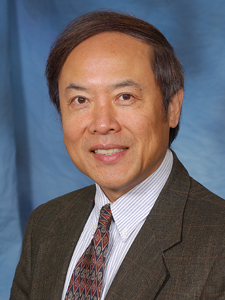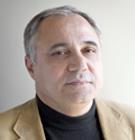Day 1 :
Keynote Forum
Donglu Shi
University of Cincinnati, USA
Keynote: In-Vitro Depth-Dependent Photo thermal Ablation of Human Adenocarcinoma by Polystyrene Stabilized Fe3O4
Time : 09:30-10:10

Biography:
Donglu Shi received his Ph. D. in Materials Science and Engineering in 1986 from the University of Massachusetts at Amherst. In 1995, Donglu Shi joined the faculty as an Associate Professor in the Department of Materials Science and Engineering at University of Cincinnati. He was promoted to the full professor position,rnwith tenure, in 2001 at University of Cincinnati. He is currently the Chair of the Materials Science and Engineering Program at the University of Cincinnati. Donglu Shi has so far published 250 refereed SCI journal publications including Physical Review Letters, Nature, ACS Nano, and Advanced Materials.
Abstract:
Nanoparticle mediated photo thermal ablation of cancerous tissue shows promising results as an efficacious treatment method. However it is important to understand the effects of greater laser attenuation on photothermal efficacy mediated by changes in the scattering and absorption profiles of soft tissue. Photothermal efficacy using a near infrared (NIR) 785nm laser irradiating polystyrene (PS) stabilized magnetite (Fe3O4) nanoparticles (PS-Fe3O4) is examined on MDA-MB-231 human mammary gland adenocarcinoma in-vitro. Agarose gel columns of various depths were created to simulate soft tissue and subsequently used for NIR laser attenuation. PS was found to significantly improve magnetite nanoparticle stability in modified Hank’s Balanced Salt Solution, serum containing media, reduces innate toxicity over 48 hours compared to uncoated magnetite, and allows for effective hyperthermic ablation. Agar gel layers provided similar optical attenuation in the NIR region to soft tissue and provided a convenient base gel material for advanced soft tissue modeling. The NIR laser power usedrndid not solely affect cellular viability, but allowed for photothermal ablation through all examined agar gel depths.
Keynote Forum
Rafael Vazquez-Duhalt
National Autonomous University of Mexico, Mexico
Keynote: Design of a VLP‑nanovehicle for CYP450 enzymatic activity deliveries
Time : 10:10-10:50

Biography:
Rafael Vazquez‑Duhalt is working as a full Professor at the Center for Nanosciences and Nanotechnology of the National University of Mexico. He earned his PhD degree in Biological Sciences from the University of Geneva, Switzerland. In addition, he carried out a three-years Post-doctoral work in the University of Alberta, Canada. He has been a visiting Professor at the University of Maryland and at the University of California, San Diego. He earned the Scopus Prize from Elsevier Publisher as Mexican researcher with higher H factor in Biotechnology and Agronomy fields in 2011, the Research Merit State Prize from the Morelos State Government in 2009, and “Thomson-Reuters” Prize to the most cited Mexican research article in Microbiology in the decade 1999-2009 in 2009. He is the author of 3 patents, published 2 books and more than 145 scientific articles.
Abstract:
The intracellular delivery of enzymes for therapeutic use has a promising future for the treatment of several diseases such as genetic disorders and cancer. Virus-like particles offer an interesting platform for enzymatic delivery to targeted cells because of their great cargo capacity and the enhancement of the biocatalyst stability towards several factors important in the practical application of these nanoparticles. We have designed a nano-bioreactor based on the encapsulation of a cytochrome P450 (CYP) inside the capsid derived from the bacteriophage P22. An enhanced peroxigenase, CYPBM3, was selected as a model enzyme because of its potential in enzyme prodrug therapy. A total of 109 enzymes per capsid were encapsulated with a 70% retention of activity for cytochromes with the correct incorporation of the heme cofactor. Upon encapsulation, the stability of the enzyme towards protease degradation and acidic pH was increased. Cytochrome P450 activity was delivered into human cervix carcinoma cells via transfecting P22-CYP nanoparticles with lipofectamine. This work provides a clear demonstration of the potential of biocatalytic virus-like particles as medical relevant enzymatic delivery vehicles for clinical applications.
Keynote Forum
George Altankov
Institute for Bioengineering of Catalonia, Spain
Keynote: Mesenchymal Stem Cells Behaviour in Nano fibrous Environment
Time : 11:10-11:50

Biography:
George Altankov is ICREA Research Professor in the Institute for Bioengineering of Catalonia. He got his MD in 1974 in Varna Medical Institute, Bulgaria, where also accomplished his PhD (1984). In 1991-1993 he made his postdoc in Southwestern Medical School at Dallas performing studies on the molecular mechanisms of cell adhesion. During his subsequent work in the Bulgarian Academy of Sciences (1985-2005) he grew up to full professor, head of department and deputy Director of the Institute of Biophysics in Sofia. His studies, performed in close collaboration with GKSS Research Centre (Germany), were among the first highlighting that tissue compatibility of materials is strongly dependent on the ability of cells to reorganize surface associated matrix proteins, such as fibronectin, vitronectin, fibrinogen and collagen. His studies resulting in more than 100 publications in peer reviewed journals and books that are frequently cited.
Abstract:
Mimicking the complex intricacies of the extracellular matrix (ECM) including three dimensional configurations were traditionally used for producing living tissues from stem cells. Electrospinning is a technique capable of fabricating nanofibers (NFs) with dimensions similar to those of the natural ECM. An advantage of electro spun NFs is that they can be further designed for organization and cell binding properties which turn them within the most promising scaffold for regenerative Nanomedicine. Here we report on the use of a novel hybrid, fibrinogen/polylactic acid (FBG/PLA) nanofibers to control the overall behaviour and differentiation potential of human adipose derived mesenchymal stem cells (ADMSCs). We were particularly interested on the dorsal and ventral cell response to nanofibers organization (random vs. aligned). We found that upon ventral contact with random nanofibers the cells developed a stellate-like morphology with multiple projections where the well-pronounced focal adhesion complexes suggest a successful cellular interaction. Time-lapse analysis however showed significantly lowered cell movements resulting in relatively short distance that they traverse in multiple directions. Conversely, an elongated cell shape with extended actin cytoskeleton and significantly increased cell mobility were typically observed when cells adhering on aligned NFs. To further follow the dorsal cell response (in third dimension) artificial wounds were created on confluent cell layers and covered with either random or aligned NFs. Time-lapse analysis showed significantly faster wound coverage (within 12 h) upon contact of cells with aligned nanofibers vs. almost absent directional migration on random samples. However, quantitative reverse transcription-polymerase chain reaction analysis for Collagen 2, Collagen 10 and SOX9 genes expression showed favourable chondrogenic response of human ADMSCs cultured on random nanofibers (50 days in complete chondrogenic medium) compared to aligned ones indicating that temporary immobilisation of stem cell might promote their differentiation.
Keynote Forum
Rafael Vazquez-Duhalt
National Autonomous University of Mexico, Mexico
Keynote: Design of a VLP‑nanovehicle for CYP450 enzymatic activity deliverys
Time : 10:10-10:50

Biography:
Rafael Vazquez‑Duhalt is working as a full Professor at the Center for Nanosciences and Nanotechnology of the National University of Mexico. He earned his PhD degree in Biological Sciences from the University of Geneva, Switzerland. In addition, he carried out a three-years Post-doctoral work in the University of Alberta, Canada. He has been a visiting Professor at the University of Maryland and at the University of California, San Diego. He earned the Scopus Prize from Elsevier Publisher as Mexican researcher with higher H factor in Biotechnology and Agronomy fields in 2011, the Research Merit State Prize from the Morelos State Government in 2009, and “Thomson-Reuters” Prize to the most cited Mexican research article in Microbiology in the decade 1999-2009 in 2009. He is the author of 3 patents, published 2 books and more than 145 scientific articles.
Abstract:
The intracellular delivery of enzymes for therapeutic use has a promising future for the treatment of several diseases such as genetic disorders and cancer. Virus-like particles offer an interesting platform for enzymatic delivery to targeted cells because of their great cargo capacity and the enhancement of the biocatalyst stability towards several factors important in the practical application of these nanoparticles. We have designed a nano-bioreactor based on the encapsulation of a cytochrome P450 (CYP) inside the capsid derived from the bacteriophage P22. An enhanced peroxigenase, CYPBM3, was selected as a model enzyme because of its potential in enzyme prodrug therapy. A total of 109 enzymes per capsid were encapsulated with a 70% retention of activity for cytochromes with the correct incorporation of the heme cofactor. Upon encapsulation, the stability of the enzyme towards protease degradation and acidic pH was increased. Cytochrome P450 activity was delivered into human cervix carcinoma cells via transfecting P22-CYP nanoparticles with lipofectamine. This work provides a clear demonstration of the potential of biocatalytic virus-like particles as medical relevant enzymatic delivery vehicles for clinical applications.
